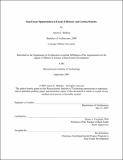Real estate opportunities in energy efficiency and carbon markets
Author(s)
Binkley, Aaron G
DownloadFull printable version (568.9Kb)
Other Contributors
Massachusetts Institute of Technology. Dept. of Architecture.
Advisor
Brian A. Ciochetti.
Terms of use
Metadata
Show full item recordAbstract
Global interest in the effects of climate change has grown rapidly in recent years. The US federal government mulls a cap and trade system for large carbon emitters while states implement their own greenhouse gas schemes. Private industries are beginning to see the need to address their greenhouse gas footprints and are increasingly offsetting their carbon emissions. The real estate industry has been under little scrutiny in spite of being responsible for over 40% of all US greenhouse gas emissions. The real estate industry is in the unique position of being able to reduce greenhouse gas emissions through energy efficiency improvements that are low cost and that create value within the underlying asset. The objective of this research is two-fold: First, to examine the potential value and feasibility of energy efficiency improvements, and second to determine if there is sufficient value creation from abatement of greenhouse gas emissions, called offsets, to subsidize further energy efficiency measures. Through a case study example I examine energy efficiency improvements at two levels and determine the resulting greenhouse gas offsets on a state-by-state basis. Then I evaluate energy savings and greenhouse gas offsets across a low and high price range. Once the case study analysis is complete, I examine the magnitude of economic value resulting from energy efficiency improvements and the sale of greenhouse gas emissions offsets for the entire real estate industry. My analysis indicates that there is potential for significant value creation. Opportunities are focused in states where energy prices are higher and where greenhouse gas emissions from power generation are greatest. In the case study, capital investment in energy efficiency has an IRR range from 26.4% to over 125%. (cont.) Greenhouse gas offset value increases IRR further; providing an additional 26% increase in the original available energy retrofit funding. Net asset value increases from 1.1% in a low carbon price scenario to 5.5% in a high carbon price scenario. At the market level, efficiency improvements are worth between $40.3 and $201 billion annually. Greenhouse gas emissions are worth an additional $1.46 to $48.8 billion. The sum of energy efficiency and greenhouse gas emissions offsets have the potential to add between 1.0% and 6.1% to the value of the $4.03 trillion US commercial real estate market. I conclude that there is significant potential for value creation resulting from rigorous energy efficiency improvements and the sale of offsets in emerging greenhouse gas markets.
Description
Thesis (S.M. in Real Estate Development)--Massachusetts Institute of Technology, Dept. of Architecture, 2007. This electronic version was submitted by the student author. The certified thesis is available in the Institute Archives and Special Collections. Includes bibliographical references (leaves 67-69).
Date issued
2007Department
Massachusetts Institute of Technology. Department of ArchitecturePublisher
Massachusetts Institute of Technology
Keywords
Architecture.